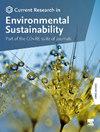Fostering unsustainability? An analysis of 4-year-olds' dietary impacts in Sweden
IF 3.7
Q2 ENVIRONMENTAL SCIENCES
Current Research in Environmental Sustainability
Pub Date : 2025-01-01
DOI:10.1016/j.crsust.2025.100281
引用次数: 0
Abstract
The dietary impacts of 746 young Swedish children were assessed across ten indicators: carbon footprint, cropland use, new nitrogen and phosphorus inputs, blue water use, ammonia emissions, pesticide use, biodiversity loss, antibiotic use, and animal welfare. This analysis utilized caretaker-reported food intake data from the Riksmaten Young Children study (2021–24). It employed the Sustainability Assessment of Foods And Diets tool to quantify these impacts against per capita 1000 kcal planetary boundaries and variations in dietary impacts based on factors such as gender, municipal area, parental education level, and consumption setting (home or preschool). We found that the mean dietary impacts fell within or exceeded the uncertainty zone per capita planetary boundaries for five out of six indicators, with only blue water use remaining within the ‘safe space’; notably, zero children had eaten below the uncertainty levels for all indicators. Boys exhibited higher dietary impacts than girls in absolute terms and when adjusted for energy intake. Children from rural areas and those with lower parental education levels also demonstrated higher impacts than their peers. Carbon footprint analysis revealed no substantial differences between home and preschool settings, with lower meat consumption in preschools offset by higher dairy intake. The primary drivers of dietary impacts were red meat, dairy products, and fruit and vegetable consumption. These results highlight substantial challenges in achieving sustainable food production and diets in Sweden while providing essential insights for informing policy and governance frameworks to promote healthier dietary patterns among young children.
求助全文
约1分钟内获得全文
求助全文
来源期刊

Current Research in Environmental Sustainability
Environmental Science-General Environmental Science
CiteScore
7.50
自引率
9.10%
发文量
76
审稿时长
95 days
 求助内容:
求助内容: 应助结果提醒方式:
应助结果提醒方式:


